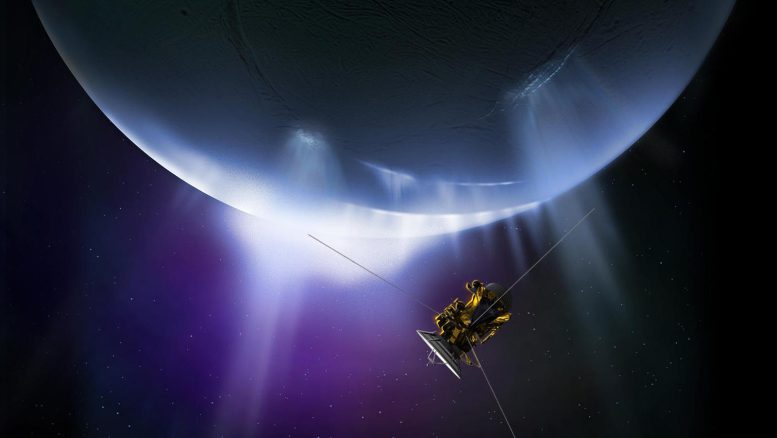
Artist’s impression of the Cassini spacecraft flying through plumes erupting from the south pole of Saturn’s moon Enceladus. These plumes are much like geysers and expel a combination of water vapor, ice grains, salts, methane, and other organic molecules. Credit: NASA/JPL-Caltech
Interaction between moon’s plumes and Saturn’s ring system explored with Webb
Enceladus—a tiny, icy moon of Saturn—is one of the most intriguing objects in the search for signs of life beyond our own planet.
Under a crust of ice lies a global ocean of salty water. Jets, supplied by that ocean, gush from the surface of the moon and feed into the entire system of Saturn. NASA’s James Webb Space Telescope’s long-awaited first look at this ocean world is already revealing staggering new details about the moon — including a plume of water vapor that spouts out more than 20 times the size of the moon itself.
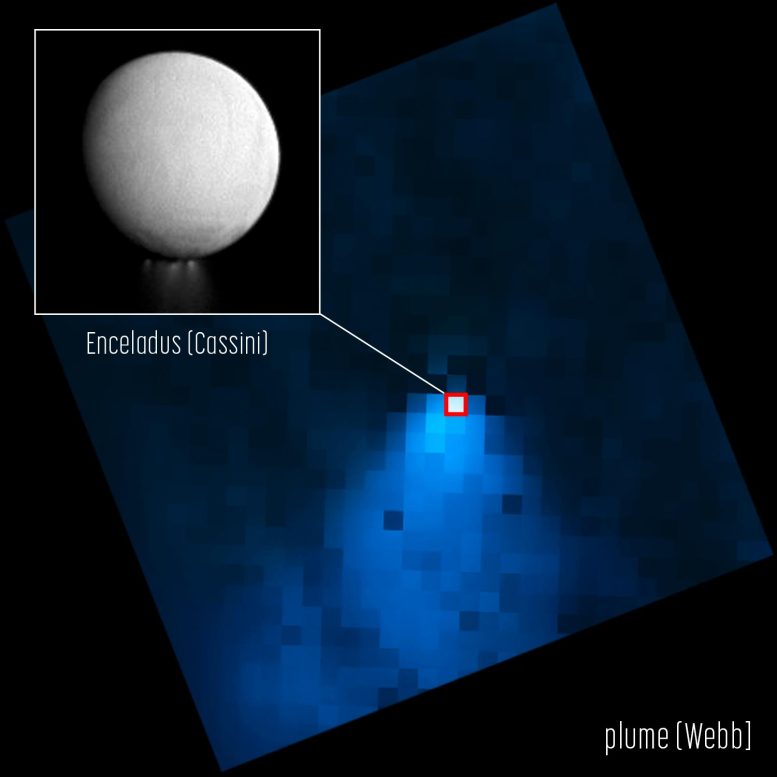
An image from NASA’s James Webb Space Telescope’s NIRSpec (Near-Infrared Spectrograph) shows a water vapor plume jetting from the southern pole of Saturn’s moon Enceladus, extending out more than 20 times the size of the moon itself. The inset, an image from the Cassini orbiter, emphasizes how small Enceladus appears in the Webb image compared to the water plume. Credit: NASA, ESA, CSA, Geronimo Villanueva (NASA-GSFC), Alyssa Pagan (STScI)
Webb Space Telescope Maps Surprisingly Large Plume Jetting From Saturn’s Moon Enceladus
A water vapor plume from Saturn’s moon Enceladus spanning more than 6,000 miles – nearly the distance from Los Angeles, California to Buenos Aires, Argentina – has been detected by researchers using NASA’s James Webb Space Telescope. Not only is this the first time such a water emission has been seen over such an expansive distance, but Webb is also giving scientists a direct look, for the first time, at how this emission feeds the water supply for the entire system of Saturn and its rings.
Enceladus, an ocean world about four percent the size of Earth, just 313 miles across, is one of the most exciting scientific targets in our solar system in the search for life beyond Earth. Sandwiched between the moon’s icy outer crust and its rocky core is a global reservoir of salty water. Geyser-like volcanos spew jets of ice particles, water vapor, and organic chemicals out of crevices in the moon’s surface informally called ‘tiger stripes.’
Previously, observatories have mapped jets hundreds of miles from the moon’s surface, but Webb’s exquisite sensitivity reveals a new story.
Researchers using NASA’s James Webb Space Telescope recently discovered a plume jetting out from the moon’s south pole more than 20 times the size of the moon itself. This animation illustrates how the moon’s water plumes feed the planet’s torus. By analyzing the Webb data, astronomers have determined roughly 30 percent of the water stays within this torus, and the other 70 percent escapes to supply the rest of the Saturnian system with water. Credit: Leah Hustak (STScI), NASA, ESA, CSA, Geronimo Villanueva, Alyssa Pagan (STScI)
“When I was looking at the data, at first, I was thinking I had to be wrong. It was just so shocking to detect a water plume more than 20 times the size of the moon,” said lead author Geronimo Villanueva of NASA’s Goddard Space Flight Center in Greenbelt, Maryland. “The water plume extends far beyond its release region at the southern pole.”
The length of the plume was not the only characteristic that intrigued researchers. The rate at which the water vapor is gushing out, about 79 gallons per second, is also particularly impressive. At this rate, you could fill an Olympic-sized swimming pool in just a couple of hours. In comparison, doing so with a garden hose on Earth would take more than 2 weeks.
The Cassini orbiter spent over a decade exploring the Saturnian system, and not only imaged the plumes of Enceladus for the first time but flew directly through them and sampled what they were made of. While Cassini’s position within the Saturnian system provided invaluable insights into this distant moon, Webb’s unique view from the Sun-Earth Lagrange Point 2 one million miles from Earth, along with the remarkable sensitivity of its Integral Field Unit (see video below) aboard the NIRSpec (Near-Infrared Spectrograph) Instrument, is offering new context.
The James Webb Space Telescope will use an innovative instrument called an integral field unit (IFU) to capture images and spectra at the same time. This video gives a basic overview of how the IFU works. Credit: NASA, ESA, CSA, and L. Hustak (STScI)
“The orbit of Enceladus around Saturn is relatively quick, just 33 hours. As it whips around Saturn, the moon and its jets are basically spitting off water, leaving a halo, almost like a donut, in its wake,” said Villanueva. “In the Webb observations, not only was the plume huge, but there was just water absolutely everywhere.”
This fuzzy donut of water that appeared ‘everywhere,’ described as a torus, is co-located with Saturn’s outermost and widest ring – the dense “E-ring.”
The Webb observations directly demonstrate how the moon’s water vapor plumes feed the torus. By analyzing the Webb data, astronomers have determined roughly 30 percent of the water stays within this torus, and the other 70 percent escapes to supply the rest of the Saturnian system of water.
In the coming years, Webb will serve as the primary observation tool for ocean moon Enceladus, and discoveries from Webb will help inform future solar system satellite missions that will look to explore the subsurface ocean’s depth, how thick the ice crust is, and more.
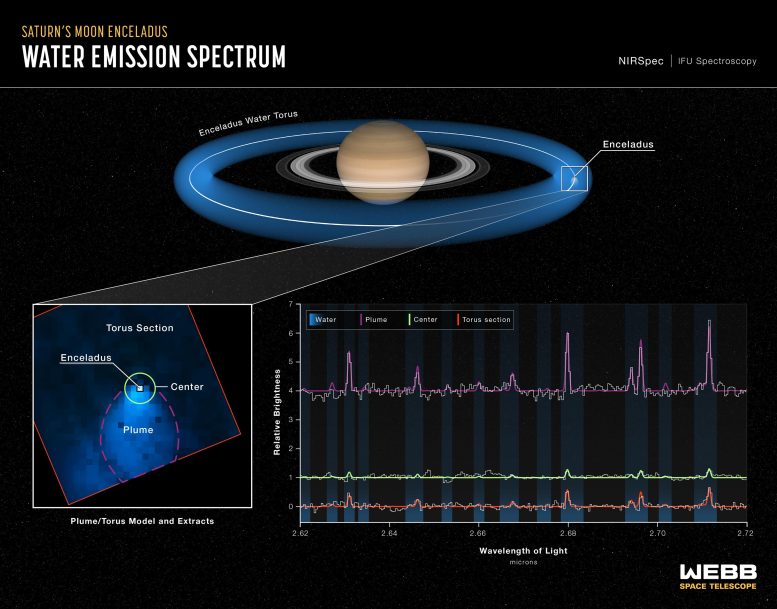
NASA’s James Webb Space Telescope’s exquisite sensitivity and highly specialized instruments are revealing details into how one of Saturn’s moon’s feeds a water supply to the entire system of the ringed planet. Enceladus, a prime candidate in the search for life elsewhere in our solar system, is a small moon about four percent the size of Earth. New images from Webb’s NIRSpec (Near-Infrared Spectrograph) have revealed a water vapor plume jetting from the southern pole of Enceladus, extending out more than 20 times the size of the moon itself. The Integral Field Unit (IFU) aboard NIRSpec also provided insights into how the water from Enceladus feeds the rest of its surrounding environment.
Enceladus orbits around Saturn in just 33 hours, and as it does, it sprays water and leaves behind a torus—or ‘donut’—of material in its wake. This torus is depicted in the top diagram in light blue.
Webb’s IFU is a combination of camera and spectrograph. During an IFU observation, the instrument captures an image of the field of view along with individual spectra of each pixel in the field of view. IFU observations allow astronomers to investigate how properties—composition in this case—vary place to place over a region of space.
The unique sensitivity of Webb’s IFU allowed researchers to detect many lines of water originating from the torus around Enceladus and the plume itself. This simultaneous collection of spectra from the plume and the torus has allowed researchers to better understand their close relationship. In this spectrum, the white lines are the data from Webb, and the best-fit models for water emission are overlaid in different colors–purple for the plume, green for the area central to the moon itself, and red for the surrounding torus.
Credit: Geronimo Villanueva (NASA-GSFC), NASA, ESA, CSA, STScI, Leah Hustak (STScI)
“Right now, Webb provides a unique way to directly measure how water evolves and changes over time across Enceladus’ immense plume, and as we see here, we will even make new discoveries and learn more about the composition of the underlying ocean,” added co-author Stefanie Milam at NASA Goddard. “Because of Webb’s wavelength coverage and sensitivity, and what we’ve learned from previous missions, we have an entire new window of opportunity in front of us.”
Webb’s observations of Enceladus were completed under Guaranteed Time Observation (GTO) program 1250. The initial goal of this program is to demonstrate the capabilities of Webb in a particular area of science and set the stage for future studies.
“This program was essentially a proof of concept after many years of developing the observatory, and it’s just thrilling that all this science has already come out of quite a short amount of observation time,” said Heidi Hammel of the Association of Universities for Research in Astronomy, Webb interdisciplinary scientist and leader of the GTO program.
The team’s results were recently accepted for publication in Nature Astronomy on May 17.
Reference: “JWST molecular mapping and characterization of Enceladus’ water plume feeding its torus” by G. L. Villanueva, H. B. Hammel, S. N. Milam, V. Kofman, S. Faggi, C. R.
Glein, R. Cartwright, L. Roth, K. P. Hand, L. Paganini, J. Spencer, J. Stansberry, B. Holler, N. Rowe-Gurney, S. Protopapa, G. Strazzulla, G. Liuzzi, G. Cruz-Mermy, M. El Moutamid, M. Hedman and K. Denny, Accepted, Nature Astronomy.
PDF
As the world’s premier space science observatory, the James Webb Space Telescope will solve mysteries in our solar system, look beyond to distant worlds around other stars, and probe the mysterious structures and origins of our universe and our place in it. Webb is an international program led by NASA with its partners, ESA (European Space Agency), and CSA (Canadian Space Agency).

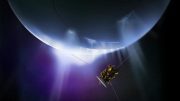
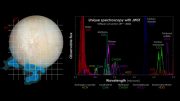
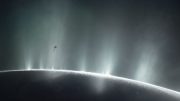
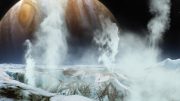

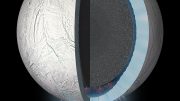

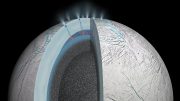
Uol